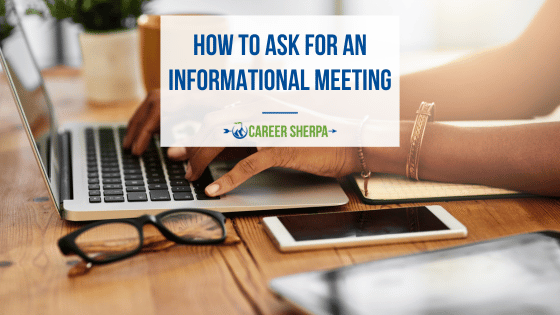Job search requires you to gather information about people, companies and industry trends. So here’s how to ask for an informational meeting.

What Is An Informational Meeting?
An informational meeting is a conversation to learn about a person, their role, the organization and/or the industry.
To learn more about what happens during the meeting read: Networking is a Waste of Time- Or Is It?
Resumes = Junk Mail
I am always dismayed when I hear job seekers blindly sending a resume as a way to create interest. What is the success rate of sending direct mail? 0-3%.
Stop sending your unsolicited resume.
Ways To Meet New People
When you hear people suggest you should make contact with people inside a company, the question inevitably is “HOW?”
How do you meet anyone?
In this new world we live in, being connected and meeting new people (online and in-person) is critical to your professional survival. Really, it is. Back to my question, how do you meet people inside a company you think you would like to work for?
- You could pick up the phone and just call. Cold calls are scary and require thick skin, but you know, sometimes they work.
- You could ask everyone you know if they know someone who works in that target company.
- You could use LinkedIn to see if you have any contacts or to at least gather some names.
- You could Google the company and see who’s been mentioned lately and reach out and congratulate them.
Your next question is. Great, I found someone, now what?
How Do I Ask For A Meeting
Though you may be in job search, you are primarily in “information gathering” mode. You need to learn about what the company or department’s goals are. You want to learn about the culture, you want to know what their problems or concerns are so that you can be a solution.
When you are requesting such a meeting (with companies who are not currently hiring) your request may sound something like:
- “I’ve recently worked on a project creating infographics and would like to talk with you about how your company is using them and where you see this concept heading in the future.”
- “I have been following what your company is doing and am really interested in how you are making strides to better inform and communicate with your customers. Would you have time to meet with me?”
- “I’m completing my degree in Design in the Spring and would really love to learn more about the clients you serve and the services they are requesting.”
All of these requests work best if you could actually drop a name as you introduce yourself.
“I was talking with Jane Smith yesterday about my design career and he suggested your name as someone who could offer really valuable advice because of your experience.”
Subject Line Suggestions for Emails
Many job seekers struggle with writing an email subject line that increases the chances of your email being opened. Writing a short but direct subject line to someone you don’t know is even more important. Here are three examples:
- “Quick Question About [Industry/Company]”
- “Interested in Learning More About [Company/Your (Job/Role)]”
- “Referral from [Mutual Contact] – Would Love to Connect”
Email Samples You’ll Need
The email you send (and I recommend email over LinkedIn messaging), should be concise, thoughtful and show that you’ve done your research. Your only asking for information, not a job! To see more sample networking emails, read this Networking Email Templates for Job Seekers.
The Initial Request for a conversation/meeting
Subject: Referral from [Mutual Contact] – Would Love to Connect
Hi [Name],
[Mutual Contact] suggested I reach out to you because of your expertise in [industry/role]. I’m very interested in learning more about [company/field] and would appreciate the opportunity to hear about your experience. Would you be open to a quick 20-minute chat? I’d be happy to work around your schedule.
Looking forward to your thoughts!
Best,
[Your Name]
[Your LinkedIn URL]
[Your phone number]
Handling No Response or Rejections
Your request for a conversation is not their top priority. The person may flat-out reject your request or they may have forgotten to respond. Show some grace and assume that they just overlooked it.
If a week has gone by and you haven’t heard back, it’s safe to assume they have forgotten. It’s up to you to gently send a reminder. You can forward the first message and add this to your forwarded note or you can send a new email. It may look like this:
Example Follow-up:
Subject: Following Up – Quick Chat?
Hi [Name],
I wanted to follow up on my previous message. I know you’re busy, but if you’re open to a brief conversation, I’d greatly appreciate it. If now isn’t a good time, I completely understand. Thanks for your time!
Best,
[Your Name]
[Your LinkedIn URL]
[Your phone number]
If they reject your request, send them a kind reply and thank them for responding. It might look like this:
Example Response To Rejection
Subject: Thank you for your response
Many thanks [Name],
I appreciate you considering my request for a brief conversation and understand how busy you must be.
I wish you well and I hope our paths with cross in the future!
Best,
[Your Name]
[Your LinkedIn URL]
[Your phone number]
Prepare For The Meeting/Conversation
Whether in-person, over the phone or via video, you want to thoroughly prepare for the conversation.
Research the person you’ll be meeting with, their company and develop your list of questions. Also know how you’ll answer the questions “and what do you do?” in under 45 seconds.
To see an actual agenda for your meeting and a list of questions you can choose from, read this Networking article.
Be Proactive
The key to your success is identifying companies in advance of their advertising a position. Once they’ve announced a job, they’ll be overwhelmed with the process and might be less likely to agree to an informational meeting, though it never hurts to try.
Now go back and create a list of 40 or so companies you believe would have a need for the kind of work you do. Begin doing some preliminary research and see who you can find who works there.

Hannah Morgan speaks and writes about job search and career strategies. She founded CareerSherpa.net to educate professionals on how to maneuver through today’s job search process. Hannah was nominated as a LinkedIn Top Voice in Job Search and Careers and is a regular contributor to US News & World Report. She has been quoted by media outlets, including Forbes, USA Today, Money Magazine, Huffington Post, as well as many other publications. She is also author of The Infographic Resume and co-author of Social Networking for Business Success.
